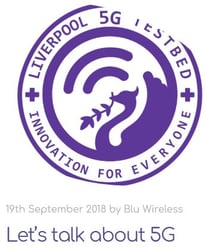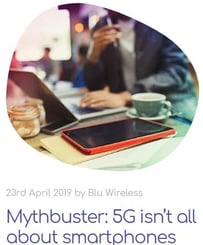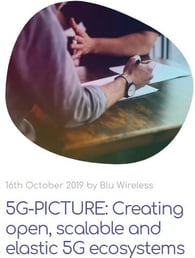5G is not one technology, it’s a collection of networking technologies, and Millimetre Wave (mmWave) provides the high-speed, multi-gigabit, carrier-grade link that can tie parts of it together. This is what truly separates 5G from 4G capabilities and is a key component of future networks.
What is 5G infrastructure?
Crucially, 5G infrastructure is much more than just a service for mobile connectivity. 5G wireless infrastructure is a communications ecosystem that will provide fibre-like speeds. Whether it uses macro cells, small cells, or any specific radio infrastructure, a wireless network can be built with exceptionally high-speed communication links quickly and cost effectively.
Our technology at Blu Wireless has many versatile applications. These span across high-speed broadband at home, fixed wireless access (FWA), public safety, backhaul for high speed transport and smart factories, to name a few.
What is millimetre wave and how does it relate to 5G?
So, where does mmWave technology come in? mmWave is the core radio wave technology that powers these high-speed communication links. It refers to a vast range of frequencies between 24GHz and 100GHz and has shorter wavelengths of 1 to 10 mm.
Licence exempt 5G mmWave uses frequencies in the 60GHz unlicensed band. This means that providers who utilise this band don’t need a licence and the spectrum can be shared by different operators.
The mmWave band spectrum is available for 5G to use, and the unlicensed 60GHz spectrum alone is much wider than all of what’s available for mobile communication, including WiFi. It offers an impressive 14GHz of spectrum compared to the narrow spectrum that connect our phones, which is in turn orders of magnitude larger than the current technology on the market.
The short wavelength frequencies can offer high-speed wireless connections because they can carry more data and the data being transferred has less distance to travel, drastically improving latency.
Short wavelength mmWave vs long-range radio
Long-range radio technology is a communications infrastructure that emits long wavelength radio wave frequencies. This could be a large cell tower, for example, sending out signals for mobile phones. In contrast, mmWave is emitted using smaller stations over a smaller area.
Longer range radio technology works by emitting bandwidth over roughly five miles using one base station. However, using one base station source for bandwidth in a large area has its own limitations. If there is another long-range station within five miles, this starts to cause problems. They can interfere with one another causing bandwidth constraints.
In contrast, with a short-range mmWave transmission, base stations are placed roughly every 400 metres. Each of these stations provide the same high bandwidth of gigabits per second. This means this level of performance is repeated within an area, creating a high density of 5G quality performance. It also means several people in an area can connect to the same spectrum using different stations creating a robust communications system.
What is licence exempt, 5G mmWave technology used for?
This unprecedented gigabit performance means mmWave is a key technology for making our society’s ambitious ideas for connectivity, Smart Cities, and all-pervasive WIFI possible.
For example, it can provide internet connection to a train-full of passengers or powering FWA for an entire enterprise.
This technology will also enable emerging applications that may change how we live and work in a city. Connected and autonomous vehicles are a good example; they require access to low-latency, reliable and high-quality connections across a large area in order to function effectively. If their connections only had the range of your home WIFI or the intermittency of 4G, they would become unsafe and almost useless.
This is part of the reason these kinds of Smart City applications are not yet prevalent in society yet, because the technology needed to power the ideas isn’t yet widely available. 5G mmWave on the other hand has the capacity to meet these requirements.
Blu Wireless’s mmWave technology delivers high-bandwidth, multi-gigabit capabilities for 5G with ease, meaning the applications for this technology can be made a reality, today. For example, our high-speed, multi-gigabit 5G technology is paving the way for communications in the high speed transport and healthcare sectors, already being seen in action, and there are plans for much more.
Related topics
What are the pros and cons of millimetre wave transmission?
Advantages
- High-Density Performance
The high-density bandwidth of mmWave increases its capacity to transfer data and provides an overall stronger connection to specific areas. This also guarantees quality will be maintained, asfrequencies can be reused to provide more data routes and frequent data transfers. So instead of bottlenecked one-way links, traffic is travelling quickly back and forth.
- Decreased Interference
Short range mmWave also provides better control over interference. Clever beamforming technology means stations can adjust their connections to avoid obstructions or overcome malfunctions. This is done by intelligently, electronically searching and finding the most suitable connection.
A short range mmWave provides more reliable, flexible, and high-quality connections compared to other radio technologies.
- Efficient
mmWave is much more efficient than today’s wireless. The beamforming capabilities direct its power directly where it needs to go, rather than sending out signals in all directions. This means there is no power wastage.
- Easy and Cost-Efficient Deployment
Shorter range and lower power mean a smaller product which can be placed onto existing infrastructure such as lampposts or buildings. This means no extra costs, no disruptive digging, and quicker installation.
This will have a huge impact for areas that don’t already have connections or are not profitable for telecoms companies to focus on. For example, rural areas that lack good connections could get reliable, high-bandwidth broadband easily and affordably using mmWave small cells.
- Scalable
Since they can be deployed easily and rapidly, with no additional infrastructure, the technology is extremely scalable. As society’s need for fast connections grow this will be an invaluable trait.
Disadvantages
- Line of Sight (LOS)
Of course, mmWave also has its limitations. The main consideration is that it works by LOS connections. This means connections travel in straight lines which can be blocked by obstacles. In other words, it can’t travel round corners, and it won’t pass through buildings.
However, using sophisticated, rerouting connections mmWave technology has been designed to overcome this potential issue.
Overall, mmWave transmission gives us the ability to create more reliable, high-quality, and cost-efficient communications that can be easily deployed at a vast scale. It’s smaller size and flexible connections also mean it can be easily customised and installed.
This means it can be used for many different applications, enabling gigabit-grade connections for more people, areas and industries than before, and in a shorter a timescale than other technologies, such as fibre.
Will 5G mmWave be available nationwide?
5G mmWave’s wide scale potential for many applications and ease of deployment means it has the potential to be deployed all across the UK and worldwide in areas such as health and the Internet of Things (IoT). However it will only be one piece of the puzzle, being used for specific purposes such as the examples above. Other connective technologies such as fibre, 4G and WiFi will continue to be used for other applications.
To find out more about how Blu Wireless are pioneering 5G mmWave technology solutions, get in touch today or fill out the form below.












